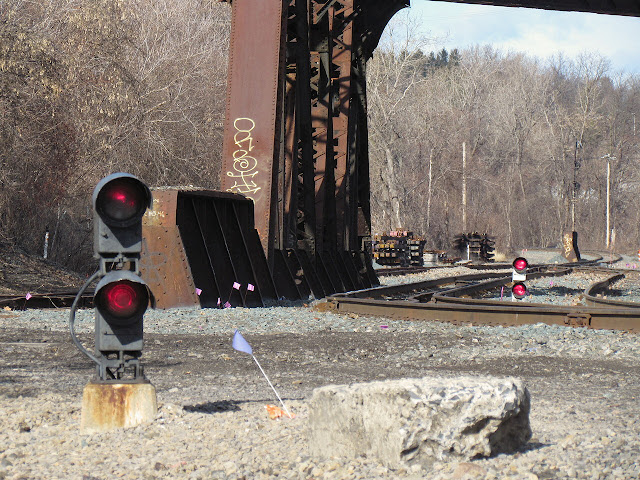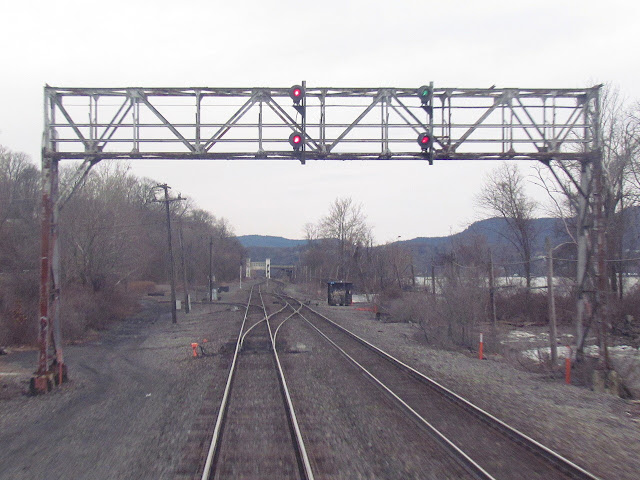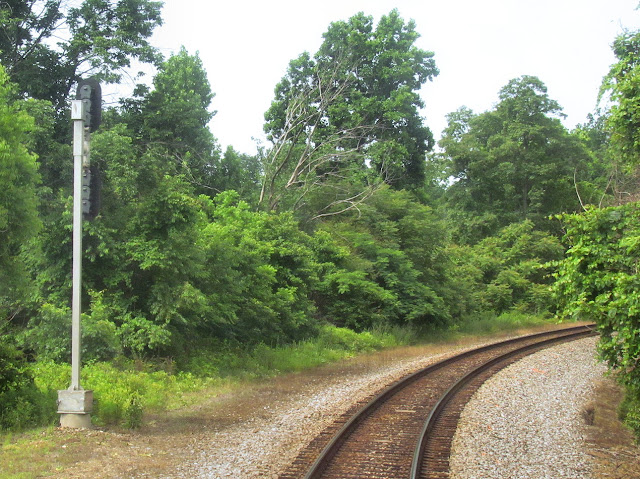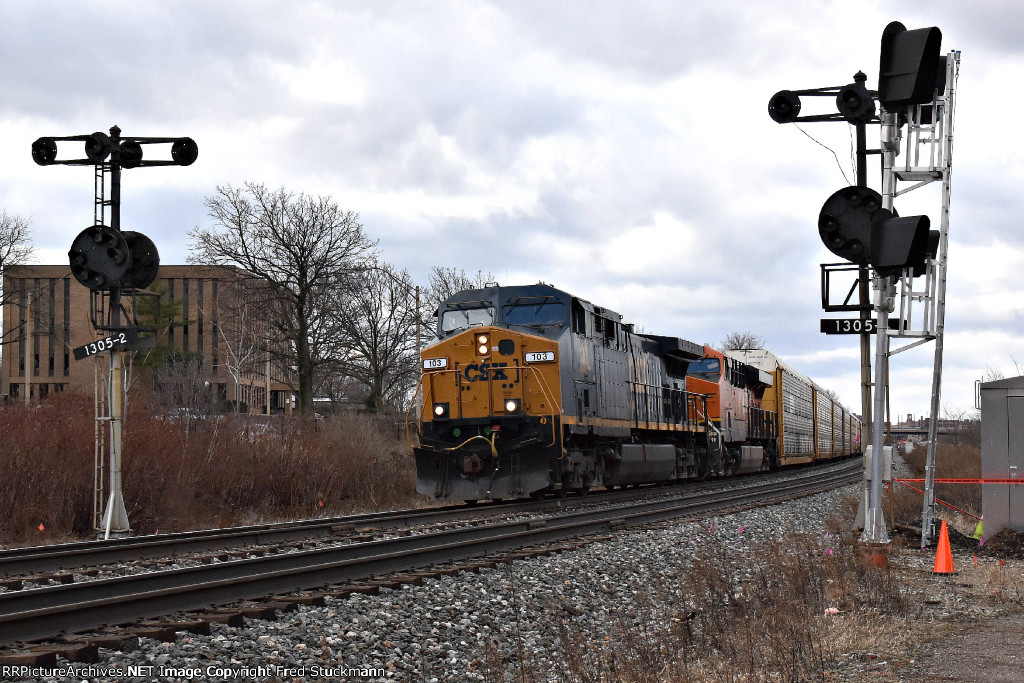The island of B&O CPL signaling in the Akron, OH area is shrinking rapidly as the iconic downtown double-double CPLs have some unwanted interlopers. I also saw that the interlocking at the west end of the double track south of town also has new signals up and I would suspect that the interlocking complex at Warwick, OH is not far behind.
The former B&O main line route between New Castle, PA and Willard has always been a bit of an odd duck with a distinct lack of investment. This was a boon to the signaling community as this preserved large swaths of Rule 251, B&O CPLs and even the interlocking tower in Newton Falls, OH. Unfortunately it appears that this will become as bland as the rest of the B&O Main Line because, if my calculation are correct, this is the last bit of B&O signaling left.
A blog devoted to explaining the ins and outs of North American railroad signaling, past, present and future. This blog seeks to preserve through photo documentation the great diversity and technical ingenuity of 20th century signaling and interlocking hardware and technology. Related topics cover interlocking towers and railroad communications infrastructure.
Note, due to a web hosting failure some of the photos and links may be unavailable.
Search This Blog
Tuesday, February 28, 2017
Monday, February 20, 2017
Amtrak Empire Corridor Status Report
Just came back from my annual trip on Amtrak's Empire corridor and I wanted to give everyone a report on the state of the signaling as various "improvement" projects progress. I had previously reported on the state of the Albany-Rensselaer terminal complex, formerly controlled by LAB tower. As of last year, CP-141 and CP-142 had been rebuilt and transferred to the new Hudson North dispatcher (on weekdays at least) along with a new CP-138 controlled point replacing the old CP-141 holdout. Rule 562 was in effect between CP-141 and CP-138 and work was ongoing to rebuild CP-143, which was placed in service later in 2016.
Fast forward a year and not only have CP-144 and CP-145 been rebuilt and placed under the control of the Amtrak dispatcher, but the second track is not in service between Albany and Schenectady. New signals at up at CP-145 with the Rule 562 No "Fixed ABS" signs in place for westbound traffic. Signals are SafeTran modular targets as were seen at CP-141 and CP-138.
I can also confirm that CP-146 has also been rebuilt to the same standard and I can also safely assume that CP-156 has met the same fate, along with all intermediate signals.
The good news is that CP-159 and CP-160, situated on either side of the Schenectady station, show no signs of reconstruction, and neither do the intermediate signals between CP-160 and the end of Amtrak ownership at CP-169 in Hoffmans. The lack of "No Fixed ABS" signs at CP-159 also hint that the two-track signal NYC signal gantry between CP-156 and CP-159 is still in service. Issues with being able to finance the Schenectady Station reconstruction will hopefully prioritize that over signal replacement.
Rewinding a bit, not effort has started on the much talked about Hudson Line re-signaling project below CP-138. It will be interesting to see what gets prioritized in the likely funding squeeze ahead.
In some related news, the last islands of classic D&H searchlights appear to be falling as new signals are ready to go up at CPF-483, located at the south end of Mohawk Yard. The classic D&H/B&M signal bridge is being replaced as well. The one interesting thing was that I was finally afforded a closeup of the CP off-brand US&S N-3 non-modular traffic light type signal. At least that's a little better than the SafeTran clamshell :-\ Also, the relay hut was freshly painted so that might also be seeing a second act.
Fortunately, years of tireless effort has allowed me to document most of the now replaced, removed or retired signaling locations.
 |
| CP-143 being rebuilt in early 2016 |
 |
| CP-145 before its 2016 rebuild |
 |
| CP-156 in 2016 with construction about to begin. |
Rewinding a bit, not effort has started on the much talked about Hudson Line re-signaling project below CP-138. It will be interesting to see what gets prioritized in the likely funding squeeze ahead.
 |
| CP-89 and its friends on the Hudson Line are so far untouched. |
Fortunately, years of tireless effort has allowed me to document most of the now replaced, removed or retired signaling locations.
Sunday, February 12, 2017
The Gosts of Winslow Junction
The following originally appeared in The Trackside Photographer in June of 2016 and was based on a trip I took on Black Friday 2015. I'd like to do more on Winslow Jct, but in the state it is in now I would need additional access to the tower interior and/or historic photos. Until then, enjoy the historic exploration angle and watch The Trackside Photographer for additional contributions in the near future.
Winslow Junction is located at the edge of the New Jersey Pine Barrens almost exactly half way between Philadelphia and the resorts in Atlantic City. The site is surprisingly rural for something set in the most density populated of the United States, however 100 years ago Winslow Junction could boast some of the highest traffic densities in the world as two railroads competed to bring millions of middle and working class passengers to the fun and leisure of the New Jersey shore.
In the few decades between the time when workers developed the ability to enjoy leisure time in the late 19th century and and when private automobiles and inexpensive air travel expanded their options in the mid 20th, Atlantic City was one of several resort cities that owed their fortunes to efficient rail transport. Like Brighton Beach, New York and Brighton, England, Atlantic City relied on a conveyor belt-like system of trains that whisked holiday seekers from the urban core to the beach in the brief period that were released from their jobs. Winslow Junction sat at the nexus of this system located at the point where the Central Railroad of New Jersey's Southern Division crossed both the Camden and Atlantic (PRR) and Atlantic City Railroad (Reading) main lines. It was also the point where the ACRR's Cape May branch split off from their Main Line with additional connections to the CNJ for its famed "Blue Comet" express service to New York City.
Improving road transport brought rapid change to the Atlantic City travel market and in 1933 the compering Pennsylvania Railroad and Reading System operations were merged into the Pennsylvania-Reading Seashore Lines. In 1934 the state of the art WINSLOW tower and its associated interlocking was constructed to bind the system together at its nexus point, replacing older mechanical towers and antiquated signaling. The air operated switches and cab signals were installed on over route 5 route miles of track, all controlled from a single power interlocking machine in a brand new brick tower.
However the story of Winslow Junction from then on would be mostly one of decline. As Atlantic City faded, tracks were cut back and the main lines were downgraded. Finally in 1983 passenger service to the shore was suspended and the interlocking plant in the middle of the Jersey pines was shuttered for good. Fortunately, state ownership meant that the artifacts were largely left in place. Reconstruction of the Atlantic City rail line in 1989 swept away some of the decay, but the tower's unbroken windows still let in sunlight to shine on the Model 14 interlocking machine for nearly 20 years before they were boarded up.
The main line to Atlantic City that in its heyday hosted the fastest scheduled passenger train service in the world is now a single track line with short passing sidings with a top speed of 80mph. The interlocking that remains in sight of the tower is just a single crossover at the south end of one of those sidings. The second track is now just a glorified storage track, albeit one sporting 136lb main line rail with some joints still still paper thin.
Year by year, bit by bit, more of Winslow's history succumbs to collectors, vandals and nature. The telegraph poles have fallen to those interested in the copper wire or blue glass insulators. The power supply was bulldozed for PCB remediation and even the half mile long ramp for the Cap May flyover was completely harvested for its supply of high quality construction sand.
If anything, Winslow Junction is a testament to the force of nature to reclaim that where the humanity tried to assert its dominance.
At the same time it is a testament to those materials of the analogue age that continue to resist the forces of nature, decades after being left to fend for themselves. Creosoted wooden ties, lead painted pipelines and even rust covered structural steel still stand strong.
Many of the classic PRR position light signals at Winslow Junction were salvaged by local railroad enthusiasts during the Amtrak rebuilding project in the late 1980's, however the former 8L signal stationed at the south junction of the connector track was rolled down the embankment to fade away.
The track connecting the former Atlantic City Line to what became the Conrail Beesley's Point freight line saw a brief resurgence after the tower was closed as it was the only way that Atlantic City bound freight traffic could access the line after the portion between the Delair Bridge and Winslow Junction was taken out of service. When the line was rebuilt the interchange moved to SOUTH WINS interlocking and the S-curving connector was first left to the weeds. In addition to the rails, this NJT friction bearing M of W flatcar found itself stuck in time.
Winslow Junction was built with no fewer than 6 rail-rail overpasses to allow movements to pass by eachother without conflict. This amount of "flight" is typically reserved for busy urban junctions like Zoo, Harold or Jamaica. Elsewhere in the country, junctions similar to Winslow would have consisted of flat switches and diamond crossings.
The air for the switches was supplied by nearly 2.5 miles of pipeline, originating at WINSLOW tower and then following the CNJ Blue Comet connection up to the ACRR junction before splitting with one line continuing down the Cape May branch and the other using the connecting track to serve the switches around the flyover bridge on the former PRR main line. Most of this impressive compressed air system was left in place where it is slowly being covered by leaves and vegetation.
Surprisingly this isn't the only abandoned pipeline at Winslow Junction. On the remaining connecting track between the CNJ and Reading are a collection of concrete blocks dating from before even the depression era WINSLOW tower. These are foundations for the mechanical pipes that ran from the original ACRR Winslow Jct tower to switches and signals on the CNJ connection.
While somewhat common overseas, the mechanical lever operated switch machine in North America was retired in 2010.
Nearly invisible from the track and ensconced in a thicket of brambles and weeds, the foundation for the 1890's vintage Reading owned ACRR tower can still be found. The upper level raised in1934, the basement continued to be used as a remote relay room and possibly as a secondary air compressor station. Today, still water tight, it is used as a clubhouse for local teens, looking to consume adult beverages away from the prying eyes of adults.
Winslow Junction is a double accident of history. Constructed in the middle of nowhere to take the masses to the shore in the pre-auto era, it was left to fade away due to having become the ward of a state that couldn't be bothered to properly dispose of it. Hopefully its secrets will linger on to inspire future generations of trackside explorers.
Winslow Junction is located at the edge of the New Jersey Pine Barrens almost exactly half way between Philadelphia and the resorts in Atlantic City. The site is surprisingly rural for something set in the most density populated of the United States, however 100 years ago Winslow Junction could boast some of the highest traffic densities in the world as two railroads competed to bring millions of middle and working class passengers to the fun and leisure of the New Jersey shore.
In the few decades between the time when workers developed the ability to enjoy leisure time in the late 19th century and and when private automobiles and inexpensive air travel expanded their options in the mid 20th, Atlantic City was one of several resort cities that owed their fortunes to efficient rail transport. Like Brighton Beach, New York and Brighton, England, Atlantic City relied on a conveyor belt-like system of trains that whisked holiday seekers from the urban core to the beach in the brief period that were released from their jobs. Winslow Junction sat at the nexus of this system located at the point where the Central Railroad of New Jersey's Southern Division crossed both the Camden and Atlantic (PRR) and Atlantic City Railroad (Reading) main lines. It was also the point where the ACRR's Cape May branch split off from their Main Line with additional connections to the CNJ for its famed "Blue Comet" express service to New York City.
Improving road transport brought rapid change to the Atlantic City travel market and in 1933 the compering Pennsylvania Railroad and Reading System operations were merged into the Pennsylvania-Reading Seashore Lines. In 1934 the state of the art WINSLOW tower and its associated interlocking was constructed to bind the system together at its nexus point, replacing older mechanical towers and antiquated signaling. The air operated switches and cab signals were installed on over route 5 route miles of track, all controlled from a single power interlocking machine in a brand new brick tower.
 |
| Winslow Tower - PRR styling, P-RSL ivy green. |
However the story of Winslow Junction from then on would be mostly one of decline. As Atlantic City faded, tracks were cut back and the main lines were downgraded. Finally in 1983 passenger service to the shore was suspended and the interlocking plant in the middle of the Jersey pines was shuttered for good. Fortunately, state ownership meant that the artifacts were largely left in place. Reconstruction of the Atlantic City rail line in 1989 swept away some of the decay, but the tower's unbroken windows still let in sunlight to shine on the Model 14 interlocking machine for nearly 20 years before they were boarded up.
 |
| Windlow Tower northbound with its replacement, NJT's SOUTH WINS interlocking. |
The main line to Atlantic City that in its heyday hosted the fastest scheduled passenger train service in the world is now a single track line with short passing sidings with a top speed of 80mph. The interlocking that remains in sight of the tower is just a single crossover at the south end of one of those sidings. The second track is now just a glorified storage track, albeit one sporting 136lb main line rail with some joints still still paper thin.
 |
| Rusted 6-bolt main line rail on the storage siding. |
Year by year, bit by bit, more of Winslow's history succumbs to collectors, vandals and nature. The telegraph poles have fallen to those interested in the copper wire or blue glass insulators. The power supply was bulldozed for PCB remediation and even the half mile long ramp for the Cap May flyover was completely harvested for its supply of high quality construction sand.
 |
| Cape May Branch flyover, abandoned in the late 1950's as shore traffic declined. |
If anything, Winslow Junction is a testament to the force of nature to reclaim that where the humanity tried to assert its dominance.
 |
| A PRR style signal ladder is all that remains of the 10L signal on the flyover bridge. |
At the same time it is a testament to those materials of the analogue age that continue to resist the forces of nature, decades after being left to fend for themselves. Creosoted wooden ties, lead painted pipelines and even rust covered structural steel still stand strong.
Many of the classic PRR position light signals at Winslow Junction were salvaged by local railroad enthusiasts during the Amtrak rebuilding project in the late 1980's, however the former 8L signal stationed at the south junction of the connector track was rolled down the embankment to fade away.
The track connecting the former Atlantic City Line to what became the Conrail Beesley's Point freight line saw a brief resurgence after the tower was closed as it was the only way that Atlantic City bound freight traffic could access the line after the portion between the Delair Bridge and Winslow Junction was taken out of service. When the line was rebuilt the interchange moved to SOUTH WINS interlocking and the S-curving connector was first left to the weeds. In addition to the rails, this NJT friction bearing M of W flatcar found itself stuck in time.
 |
| The 1934 southbound P-RSL Cape May ramp ducks under the older connection between Reading and PRR main lines. The pipe carried the compressed air supply to the south end of the interlocking plant. |
Winslow Junction was built with no fewer than 6 rail-rail overpasses to allow movements to pass by eachother without conflict. This amount of "flight" is typically reserved for busy urban junctions like Zoo, Harold or Jamaica. Elsewhere in the country, junctions similar to Winslow would have consisted of flat switches and diamond crossings.
 |
| Winslow air line near the top of the Blue Comet ramp. |
The air for the switches was supplied by nearly 2.5 miles of pipeline, originating at WINSLOW tower and then following the CNJ Blue Comet connection up to the ACRR junction before splitting with one line continuing down the Cape May branch and the other using the connecting track to serve the switches around the flyover bridge on the former PRR main line. Most of this impressive compressed air system was left in place where it is slowly being covered by leaves and vegetation.
 |
| Air line running along the shoulder of the county road close to the tower. |
 |
| Concrete footings for a mechanical pipeline run down the CNJ connection to the location of the former wye switch where footings for old signals can also be found. |
 |
| Pipeline footings pointing towards the remains of the old ACRR Winslow Jct tower. |
Winslow Junction is a double accident of history. Constructed in the middle of nowhere to take the masses to the shore in the pre-auto era, it was left to fade away due to having become the ward of a state that couldn't be bothered to properly dispose of it. Hopefully its secrets will linger on to inspire future generations of trackside explorers.
Tuesday, February 7, 2017
NS Windup Signals Winding Down
So I was out this weekend documenting some locations on the former N&W H-Line in West Virginia and I saw an intermediate signal being replaced and it prompted me to devote a whole post to the interesting experiment of NS installing what I like to call "windup signals" in Virginia and Pennsylvania around the turn of the century.
Windup signals are a type of signal mast that avoids the need for a ladder to service the heads and change the bulbs. Instead, an internal cable mechanism allows a maintainer to crank the entire head assembly up and down so that all the work that used to be done from a ladder of bucket truck, can be performed from the safety of the ground. they were typically employed as stand alone replacements, although they were used in a few re-signaling schemes (typically automatic only).
The idea is that working from the ground would not only be faster, but also avoid a large number of injury claims that can result from workers climbing signal ladders in the dark or inclement weather. This concept is increasingly found in Europe, although they tend to prefer tip over signals that can be unlatched at the base and then tipped over for servicing. However the reason it never caught on in the United States was because instead of just being able to work on a signal and have trains pass as if it were dark, the entire signal has to be taken out of service. This meant a train order had to be passed to any train in the area that such and such a signal simply didn't exist until further notice. I don't know if this safety issue came up after the windup signals started to be installed or if NS felt the hassle was justified, but whatever the case, NS soon switched to 'tombstone" style Darth Vaders and never looked back.
Personally I've always detested windup signals because they just reek of cheapness. They look like toys instead of signals and also lack the always positive feature of user serviceability. Still, they are different and in this increasingly bland signaling environment that is something I can appreciate. The good news is that a number of windups went in on the former Conrail Harrisburg Line when that was re-signaled in the early 2000's and it appears that the PTC menace will not involve many signal replacements, so any fans out there will still have a place to get some photos.
 |
| Old windup at JC cabin |
 |
| Windup at ORANGE interlocking |
 |
| Windup intermediate just south of Culpepper, VA |
Subscribe to:
Posts (Atom)






